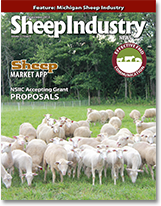Increased Selenium Dosage Boosts Growth in Lambs
DANIEL ROBISON
Oregon State Extension
(Sept. 1, 2013) Sheep given supplements of organic selenium above U.S. government recommendations showed improved growth, weight and immunity, according to new research at Oregon State University (OSU).
In a new study published in the Journal of Animal Science, OSU researchers show that maximum selenium levels permitted by the U.S. Food and Drug Administration may be too low for sheep to reach optimum growth and health.
Selenium is essential for cellular function in animals and aids development. Large selenium doses can be toxic, but too-low levels can impair growth and compromise the immune system.
“When sheep don’t grow to their potential or have weak immune systems, it can be a sign of insufficient selenium,” said Gerd Bobe, co-author of the study and an OSU professor. “Our research shows higher levels of selenium can result in healthier animals that grow bigger and that can improve returns at the marketplace for farmers and ranchers.”
Normally, grazing animals eat ample amounts of selenium from grass and other plants grown in soils naturally containing the element. Yet the soils of the Pacific Northwest are low in selenium, and the region’s livestock often need it added to their diets to avoid health problems.
A challenge is that the range between selenium deficiency and selenium toxicity can be narrow; current FDA regulations limit the amount of dietary selenium supplementation for animals grazing on selenium-scare soils – up to 0.7 mg per sheep per day or 3 mg per beef cattle per day.
In OSU’s experiments, pregnant ewes were given selenium doses up to five-times higher than the FDA’s allowed level – an amount of supplementation researchers determined to be not harmful to sheep. The element is carried into the bodies of offspring, helping young animals during development.
At the highest amount, ewes gave birth to lambs that grew to be 4.3 pounds heavier than average after 60 days. Furthermore, survival was 15-percent higher in lambs receiving the highest amount of organic selenium supplementation. As farmers look to sell sheep at five to six months old, weight and health metrics are keys to profitability.
Selenium also boosted an important gauge of the lambs’ immune systems. Levels of immunoglobulin G, a protein that defends against pathogens and is essential for lamb survival, were elevated by 48 percent in Polypay ewes and 23 percent in all ewes given five times maximum FDA-permitted levels of selenium.
The changes were measured in colostrum of ewes – a mother’s first milk that is rich in immunoglobulins and vital for building the immune system and protecting against pathogens.
OSU has a long legacy of selenium research. Half a century ago, OSU animal scientist, Jim Oldfield, was the first to identify severe selenium deficiency as a reason for several deadly diseases in animals, including cardiomyopathy and white muscle disease.
A new generation of OSU research is attempting to determine how much selenium and in what form is best for optimal growth and health of sheep and cattle.
Consumers may also benefit from eating meat from selenium-supplemented animals, as its one of the major sources of the element in the U.S. diet. Human observational studies suggest that regions with low selenium intake have a greater risk of cancer and cardiovascular diseases, Bobe said.
“Consuming selenium-enriched foods may be a viable alternative for getting extra selenium,” said Bobe, an expert in human and animal nutrition. “Plus, selenium-enriched animal products, including meat, are sold in other countries at a premium price.”
OSU’s selenium research is a collaboration between Bobe, Gene Pirelli and Wayne Mosher in the College of Agricultural Sciences and Jean Hall, Charles Estill and Jorge Vanegas in the College of Veterinary Medicine.


